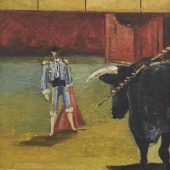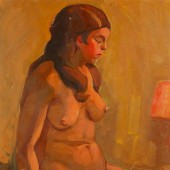Adham Wanly
- Country: Egypt
- Exhibition:
- A Century in Flux
Adham and his older brother Seif, were from a wealthy family of Turkish origin, and grew up in Alexandria, among an international cosmopolitan community with a thriving literary and artistic intellectual life. In 1935, the brothers opened their own art studio in the city with other painters and the filmmaker Mohammed Bayoumi. Wanly was well-regarded as a caricaturist and produced many character sketches for the literary magazine Rose al-Youssef and others. After traveling through Europe, he drew and painted scenes of the theatre, opera and bullfighting. In 1957, he was appointed professor at the Faculty of Fine Arts in Alexandria and two years later, he joined his brother in the Ministry of Culture’s program of documenting the Aswan High Dam project. Whilst visiting Upper Egypt, he began a series of sketches and paintings of the villages and archaeology that reinforced preconceptions of a division between urban and rural life. These included Qurya Nubia (“Nubian Village”), that shows the structures of a sparsely populated small village set against a hilly and mountain background. He tragically died that same year, probably before completing this project. Wanly’s style was distinguished by an emphasis on light and tone, or what the art historian Izz al-Din Najib referred to as a “musical symphony of lines and colours”. His works are found at the Seif and Adham Wanly Museum in Alexandria, as well as at other museums in Egypt, Doha and now in Sharjah.
ولد أدهم وشقيقه الأكبر سيف لعائلة ثرية من أصول تركية، ونشأا في الإسكندرية وسط مجتمع ذو ثقافة عالمية ومحيط حافل بالنشاطات الفكرية والأدبية والفنية. وفي عام 1935، افتتح الأخوان وانلي مرسمهما الخاص مع فنانين آخرين والمخرج السينمائي محمد بيومي. وحظي وانلي بتقدير كبير كرسام كاريكاتير، حيث نشر العديد من رسومات الكاريكاتير في مجلة "روز اليوسف" الأدبية وغيرها. وبعد سفره حول أوروبا، رسم وانلي مشاهد مختلفة من عروض المسرح والأوبرا ومصارعة الثيران. وفي عام 1957، تم تعيين وانلي أستاذاً بكلية الفنون الجميلة في الإسكندرية، وبعد عامين، انضم إلى شقيقه في برنامج وزارة الثقافة لتوثيق مشرع بناء السد العالي في أسوان. وأثناء زيارته لصعيد مصر، بدأ سلسلة من اللوحات التي تصوّر القرى والمعالم الأثرية، والتي عززت المفاهيم السابقة التي تقضي بوجود فرق بين الحياة الحضرية والريفية. ومن هذه اللوحات "قرية النوبة"، والتي تصوّر معالم قرية صغيرة قليلة السكان تتوضع مقابل خلفية جبلية منحدرة. وقد توفي وانلي بشكل مأساوي في ذات العام، وربما قبل الانتهاء من هذا المشروع. وتميز أسلوب وانلي بالتشديد على الضوء والتناغم، وقد وصف المؤرخ الفني عز الدين نجيب أسلوبه بأنه "سيمفونية موسيقية من الخطوط والألوان". وتعرض أعماله في متحف سيف وأدهم وانلي في الإسكندرية، ومتاحف أخرى في مصر والدوحة وحالياً في الشارقة.
Related artists by country
- Ahmed Askalany
- Adam Henein
- Chant Avedissian
- Fathi Afifi
- Fathi Hassan
- George Bahgory
- Ghada Amer
- Huda Lutfi
- Khaled Hafez
- Lara Baladi
- Abdel Hadi El Gazzar
- Ahmed Moustafa
- Raafat Ishak
- Susan Hefuna
- Youssef Nabil
- Gazbia Sirry
- Ragheb Ayad
- Seif Wanly
- Samir Rafi
- Omar El Nagdi
- Hamed Nada
- Kamel Moustafa
- Kareem Lotfy
- Mahmoud Said
- Mohammed Naghi
- Nermine Hammam
- Youssef Kamel
- Hazem Mahdy
- Ayad Al Nimar
- Mohammed Ismail
- Adel El Siwi
- Guirguis Lotfy
- Hussein Bicar
- Inji Efflatoun
- Kamel El Telmesani
- Khaled Zaki
- Moataz Nasr
- Reda Abdelrahman
- Shaaban Zaki
- Effat Naghi
- Farghali Abdel Hafiz
- Mohammed Sabry
- Wael Darwish
- Mohammed Abla
- Ahmed Kassem
- Marwa Adel
- Ammar Abo Bakr
- Basim Magdy
- Ganzeer
- Iman Issa
- Mohamed Abou El Naga
- Clea Badaro
- Farida El Gazzar
- Hamed Ewais
- Maha Maamoun
- Marguerite Nakhla
- Ramses Younan
- Salah Abdel Kerim
- Yasser Rostom
- Amr Nazeer
- Aya Tarek
- George Hanna Sabbagh
- Nadim Raef
- Tahia Halim
- Hussein Fawzi
- Ahmed Morsi
- Walid Ebeid
- Ezequiel Baroukh
- Saad El Khadem
- Van Leo
- Mamdouh Ammar
- Salah Taher
- Zeinab Abd El Hamid
- Armen Agop
- Wassef Boutros-Ghali
- Menhat Helmy
- Mariam Abdel-Aleem
- Hamed Abdalla
- Alaa Awad
- Ehsan Mokthar
- Fatma Arargi
- Salam Yousry
- Anna Boghighuian
- Gamal El Sagini
- Leila Izzat
- Mahmoud Afifi
- Nadia Mohammed
- Rebab Nemr
- Khadiga Riad
- Abdel Badie Abdel Hay





